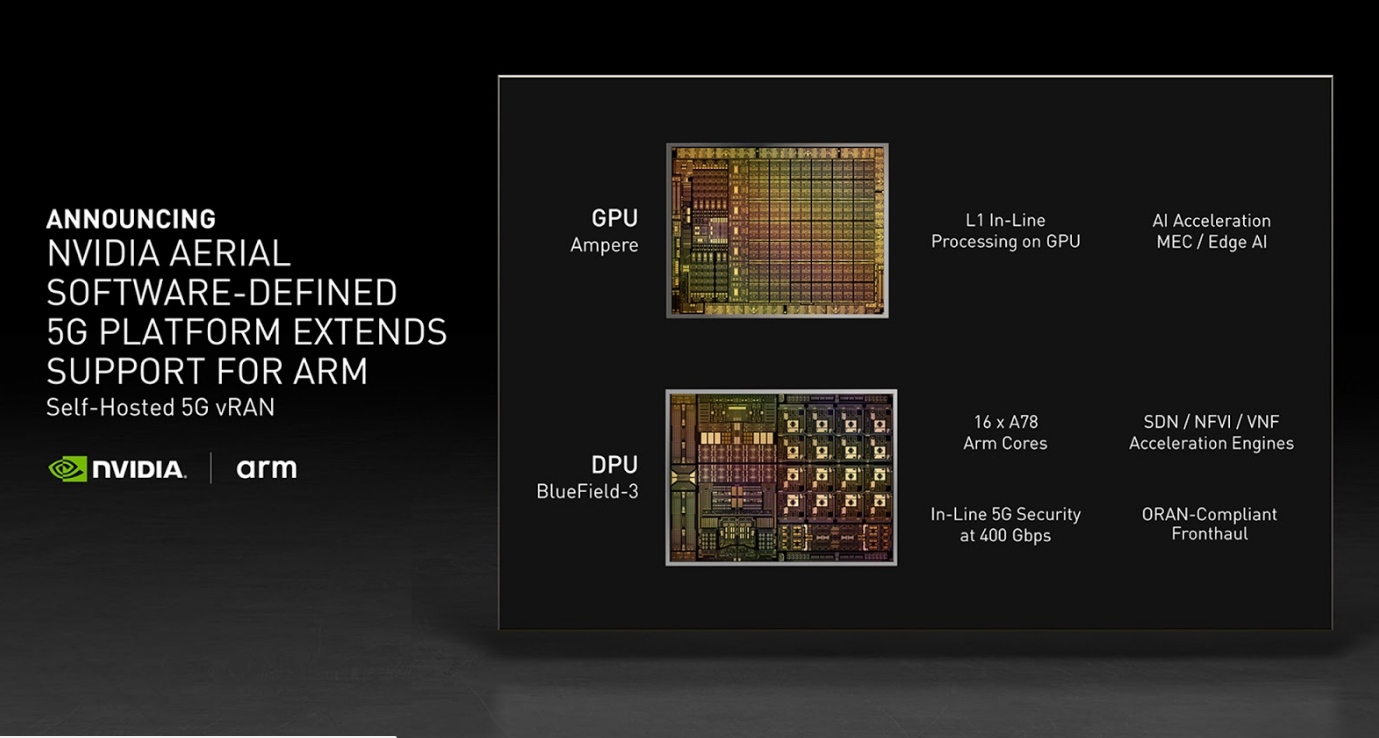 INFRA
INFRA
 INFRA
INFRA
 INFRA
INFRA
Nvidia Corp. is stepping up its bid to power 5G applications at the edge of the network, adding support for Arm central processing units on its Nvidia Aerial A100 AI-on-5G platform.
Aerial A100 AI-on-5G is a single, converged platform that’s designed to provide both artificial intelligence computing at the edge and 5G connectivity. Launched in April, it combines the Nvidia Aerial software development kit with the company’s Nvidia BlueField-2 A100, which itself is a converged card that pairs multiple CPUs with Nvidia’s data center processing units.
The platform is meant to power high-performance, software-defined 5G base stations and AI applications, such as precision manufacturing robots, automated guided vehicles, drones, wireless cameras, self-checkouts and others. In other words, it gives enterprises an option for deploying intelligent services at the edge.
Today’s announcement, made at the 2021 Mobile World Congress event in Barcelona, is all about bringing more choice to users, Nvidia said, since the Aerial A100 AI-on-5G platform already supports x86-based CPUs sold by Intel Corp. The company say the Nvidia-certified systems will create a “simplified path to building and deploying self-hosted vRAN that converges AI and 5G capabilities across private enterprises, network equipment companies, software makers and telecommunications services providers.”
Nvidia said the Arm version of the Aerial A100 AI-on-5G platform will combine 16 Arm Cortex A78 processors with the upcoming Nvidia BlueField-3 DPU, resulting in a self-contained, converged card for running edge AI apps over cloud-native 5G virtual radio area networks.
Nvidia’s support for Arm CPUs is not unexpected, given that Nvidia is currently in the process of acquiring Arm for $40 billion. That deal has attracted some scrutiny from regulators, and is not expected to be completed until next year.
“We’re bringing together two worlds — AI of computing and 5G of telecommunications — to create a software-defined platform for AI on 5G,” said Ronnie Vasishta, Nvidia’s senior vice president of telecom. “Now supporting Arm, our growing Aerial platform is accelerating AI-on-5G everywhere.”
Nvidia’s new BlueField-3 A100 DPUs are said to be developed especially for AI and accelerated computing workloads. They’re optimized for 5G connectivity and designed to work hand-in-hand with CPUs. They take care of infrastructure administration tasks such as scanning network traffic for malware and orchestrating storage. Normally these things would be handled by the CPU, so by offloading them to the DPU, it frees those up to focus solely on compute.
The BlueField-3 DPUs, which will become available in the first half of 2022, will also include Nvidia’s extensive AI software libraries, including pre-trained models, and the Aerial 5G SDK, which help developers to speed up time to deployment and add various AI capabilities to their apps.

“Bluefield-3 expands the Arm ecosystem by offering a combination of Nvidia’s accelerated computing and Arm performance to enable network providers more choice in how they create and deploy 5G systems,” said Chris Bergey, senior vice president and general manager of Arm’s Infrastructure Line of Business.
Creating the platform is one thing, but getting customers to adopt it is quite another, and for that reason Nvidia announced a partnership with Google LLC to create its first AI-on-5G Innovation Lab.
The lab will be made available to network infrastructure providers and AI software creators that want to develop and test solutions on the new Nvidia platform. Google is putting forward Google Anthos, which is a platform for developing multicloud and edge applications.
That should tempt developers, because Anthos is a popular offering in its own right. It enables developers to create cloud-native, containerized applications managed by Kubernetes that can run on any kind of cloud or edge infrastructure.
“Google Cloud, with our Anthos application platform, is enabling service providers and enterprises across many vertical markets to connect seamlessly over 5G at the network edge,” said Shailesh Shukla, Google Cloud Networking vice president and general manager. “We’re excited to extend our collaboration with Nvidia.”
The companies said they’re hoping to get the lab up and running before the end of the year.
Constellation Research Inc. analyst Holger Mueller told SiliconANGLE that the battle for 5G and edge is being waged on the platform side, and that it will be won by whoever builds the most compelling offering and sees the most enterprise adoption.
“Nvidia is making progress on both fronts, adding support for popular Arm chips on its 5G AI software platform,” Mueller said. “Nvidia is also making progress on the adoption front, partnering with Google to enables enterprises to familiarize themselves with its 5G AI platform and build apps for it with Google Anthos.”
Support our mission to keep content open and free by engaging with theCUBE community. Join theCUBE’s Alumni Trust Network, where technology leaders connect, share intelligence and create opportunities.
Founded by tech visionaries John Furrier and Dave Vellante, SiliconANGLE Media has built a dynamic ecosystem of industry-leading digital media brands that reach 15+ million elite tech professionals. Our new proprietary theCUBE AI Video Cloud is breaking ground in audience interaction, leveraging theCUBEai.com neural network to help technology companies make data-driven decisions and stay at the forefront of industry conversations.